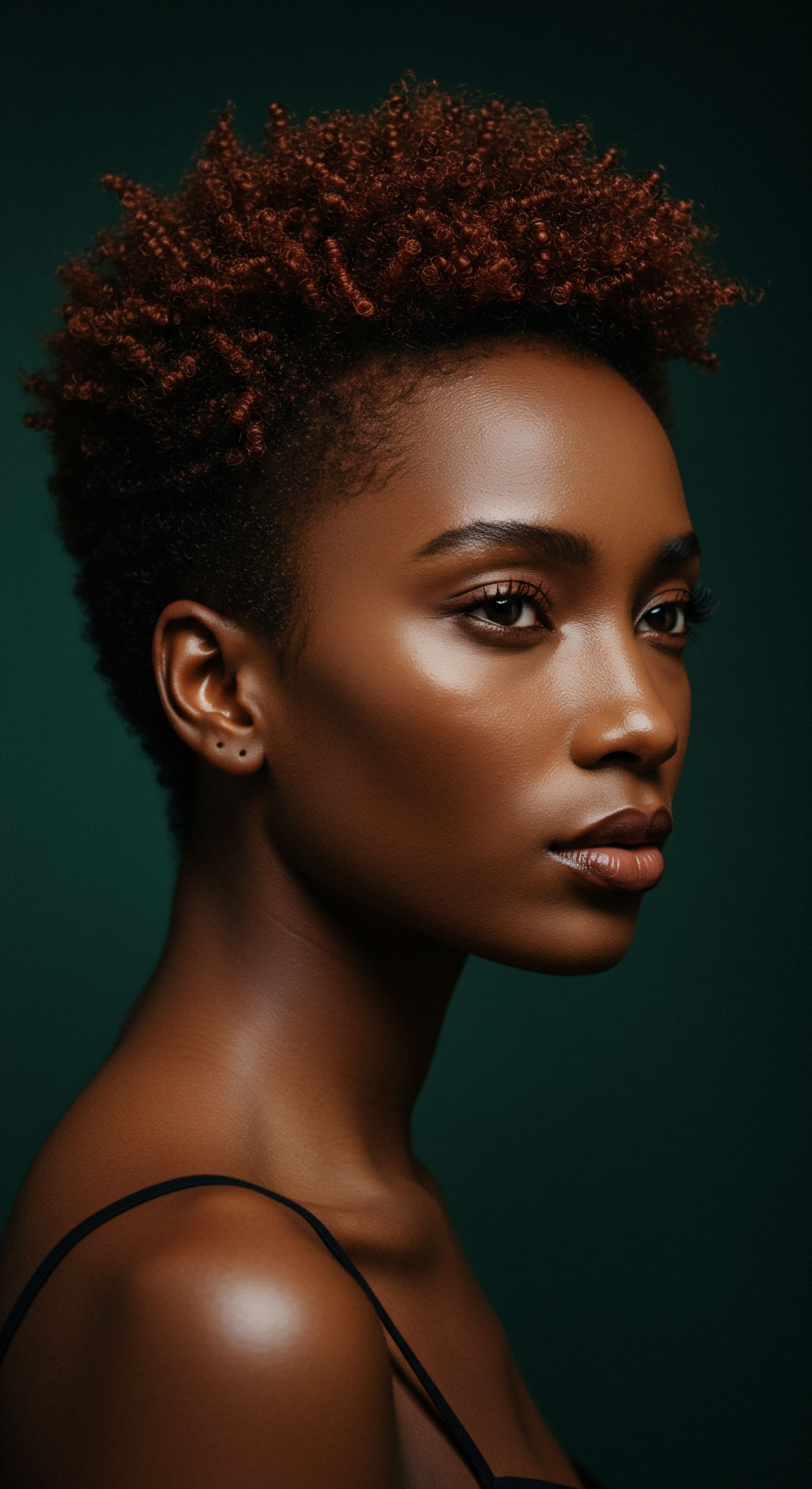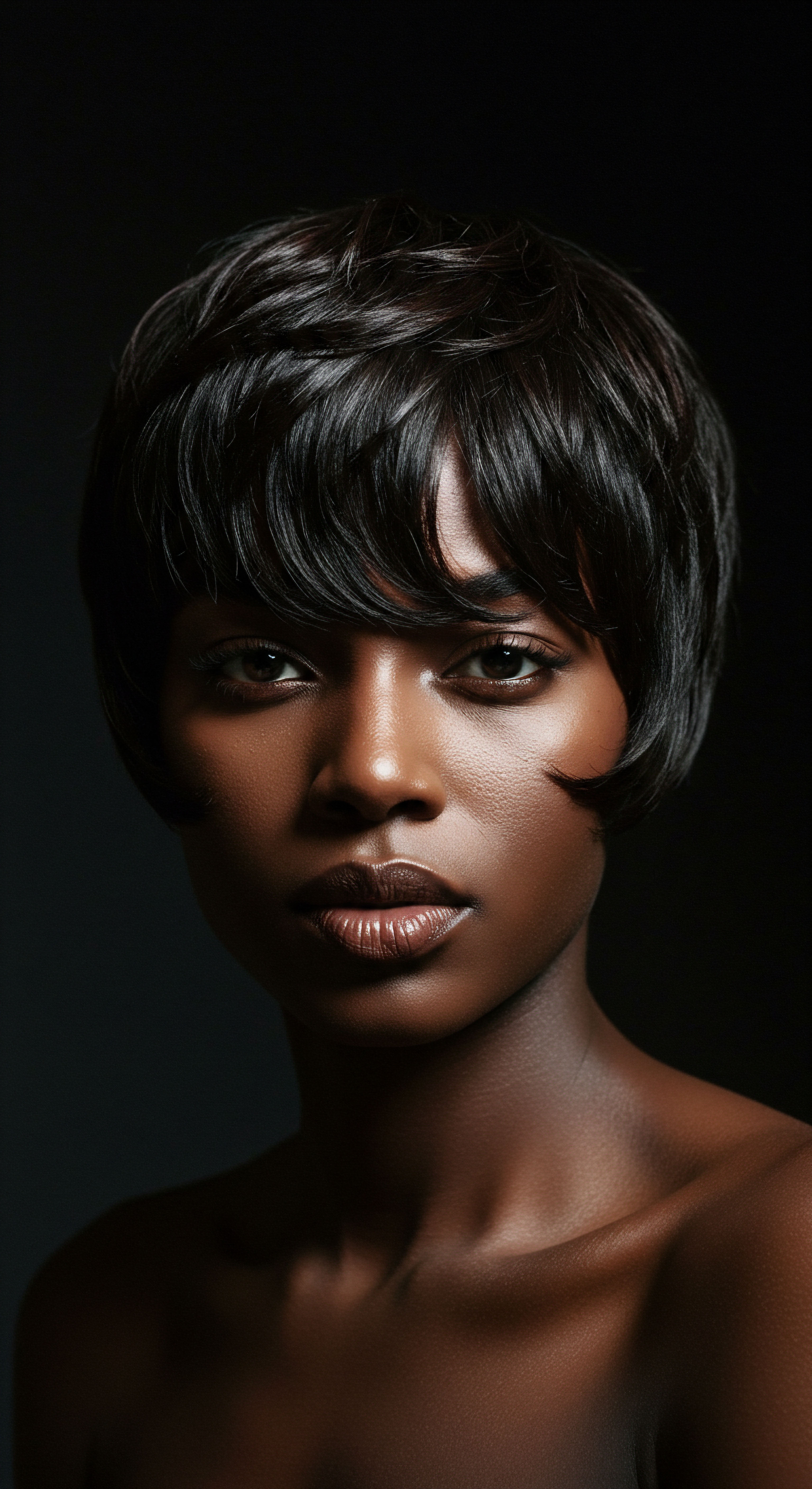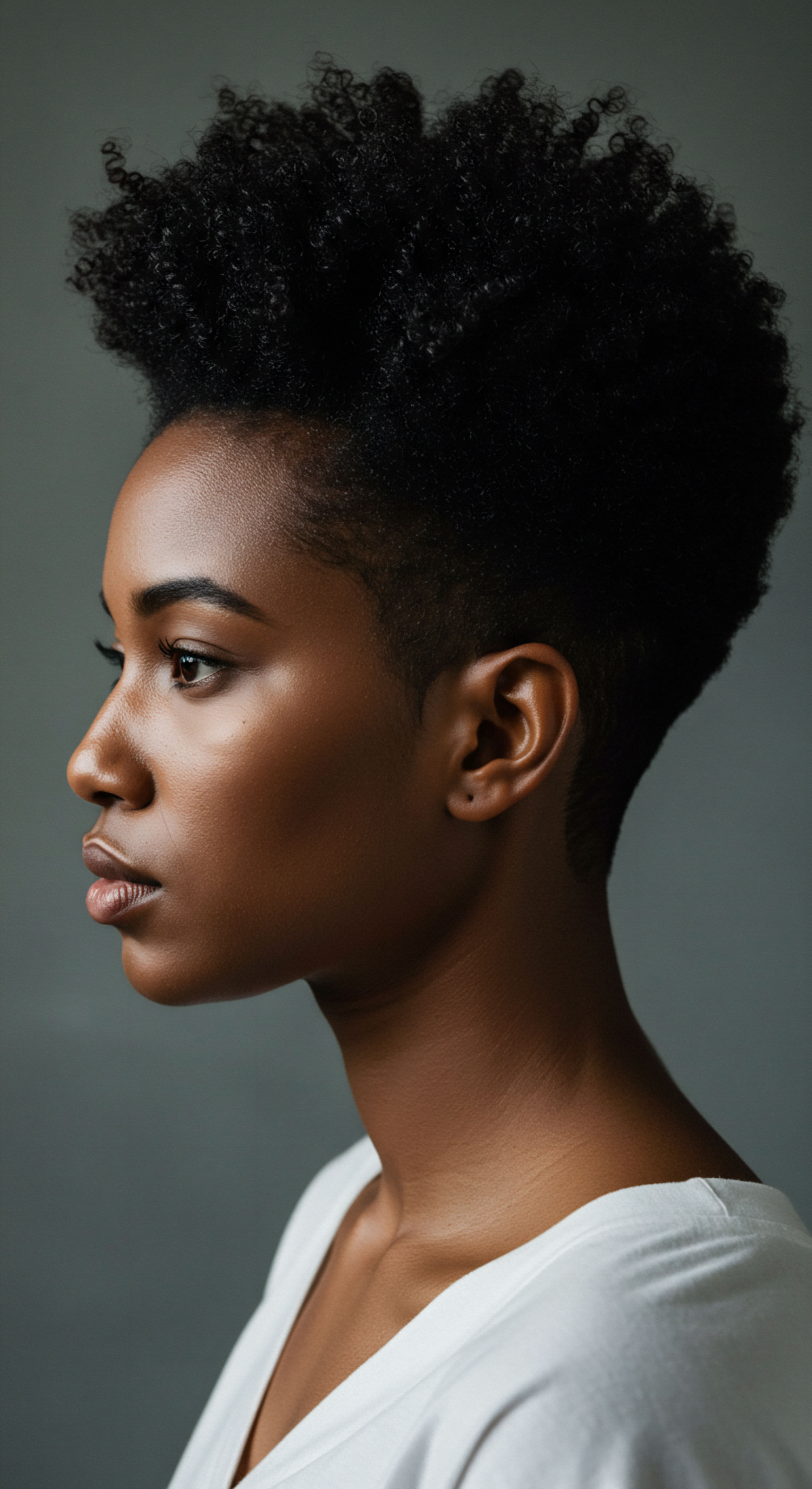
Roots
The story of human hair is not merely one of aesthetic preference or passing trends; it is a profound narrative etched into the very core of our shared existence. From the earliest whispers of civilization, hair has held a quiet yet persistent purpose, stretching beyond mere adornment. It has been a silent witness to humanity’s oldest needs ❉ shelter from the elements, a declaration of belonging, and a shield against the unseen.
To truly grasp the depth of its historical significance, we must first consider the elemental, the primal connection between our strands and the world around us. This understanding begins at a place where practical need met nascent cultural expression, long before complex societies began to shape our perceptions of beauty and status.

Hair as Early Human Shelter
In the dawn of human history, hair served as a fundamental layer of protection. Consider our early ancestors, living in direct communion with diverse and often challenging environments. Hair, particularly on the head, acted as a natural insulator against extreme temperatures. It provided a barrier against the scorching sun, guarding the scalp from harmful ultraviolet radiation.
Studies have even indicated that hair, particularly more tightly curled varieties, offers increased protection against heat gain from solar radiation. This natural canopy also offered a degree of warmth in colder climates, trapping air close to the scalp to reduce heat loss. Beyond temperature regulation, hair provided a physical shield from environmental irritants such as dust, debris, and insects.
From ancient deserts to chilly caves, hair offered early humans a primary shield against environmental extremes.
This protective function was not a matter of choice, but a biological imperative. The density and texture of hair, influenced by geographical location and ancestral origins, contributed to its efficacy as a natural defense. For instance, populations in equatorial regions often possess hair textures that provide optimal sun protection, a testament to long-term adaptation. As humans migrated and settled in varied landscapes, their hair continued to perform these basic, life-sustaining roles, shaping early communal understandings of its inherent value.

What Early Societies Valued in Hair?
Beyond its biological utility, hair quickly gained cultural value in early societies. Its condition often signaled health and vitality, attributes essential for survival and reproduction. A lustrous, well-maintained head of hair could suggest access to resources, good nutrition, and overall well-being. This early association with health likely contributed to rudimentary hair care practices, even if those practices were simply based on observation and readily available natural materials.
- Health Indicator ❉ The vigor of one’s hair often spoke volumes about physical condition.
- Environmental Adaptation ❉ Hair density and curl pattern served as natural shields against sun and cold.
- Resource Availability ❉ Healthy hair could signal access to nourishing foods and clean water.
The earliest forms of hair protection were likely simple yet effective. Animal fats, plant oils, and natural clays were probably among the first conditioning and styling agents. These substances would not only have helped to keep hair moisturized and pliable, preventing breakage from harsh conditions, but also offered additional layers of physical protection.
For example, some indigenous tribes historically used mixtures of clay and cow fat to create hair pastes that shielded against the sun and aided in detangling. These early applications underscore a fundamental truth ❉ the desire to protect hair, and by extension, the individual, is as old as humanity itself.
As human groups formed more complex social structures, the meaning of hair began to deepen. It moved from a purely practical shield to a canvas for expression, a marker of identity, and a conduit for spiritual connection. The protective aspects remained, but they began to intermingle with emerging social and ceremonial roles, setting the stage for the intricate customs that would follow.

Ritual
Stepping from the elemental into the communal, we find hair protection evolving from simple necessity to profound practice. Our inquiry into the historical significance of hair care begins to touch upon the daily or periodic rhythms that shaped lives across continents. This is where the practical wisdom of ancient peoples truly shines, as techniques and methods were honed, passed down, and imbued with shared meaning. It is a space where the tactile sensation of oils, the rhythm of braiding, and the comforting weight of a head covering speak volumes about care, connection, and the enduring human spirit.

Ancient Traditions of Hair Preservation
Across diverse civilizations, ancient societies developed elaborate practices for preserving and maintaining hair, recognizing its inherent value. These methods often served dual purposes ❉ safeguarding the hair from environmental damage and marking social standing or spiritual devotion. In ancient Egypt, for instance, hair was seen as a source of vitality and power.
Castor oil and almond oil were highly valued for their moisturizing qualities, offering protection against the harsh desert climate. Wigs, often made from human hair or plant fibers, were worn not only as symbols of status but also as protective coverings, shielding natural hair and scalp from the sun.
The meticulous attention paid to hair in these cultures points to a collective understanding that healthy hair was a sign of a healthy person, both physically and perhaps spiritually. These were not casual acts; they were often deliberate rituals, sometimes accompanied by specific prayers or intentions, reflecting a deep respect for the body and its connection to the wider world.
| Culture or Region Ancient Egypt |
| Material Used Castor oil, almond oil, wigs |
| Primary Protective Purpose Moisture retention, sun protection |
| Culture or Region West Africa |
| Material Used Shea butter |
| Primary Protective Purpose Moisturizing, shield from harsh conditions |
| Culture or Region Native American Tribes |
| Material Used Yucca root, aloe vera, plant oils |
| Primary Protective Purpose Cleansing, conditioning, sun shield |
| Culture or Region Ancient Greece and Rome |
| Material Used Olive oil, herbal infusions |
| Primary Protective Purpose Conditioning, adding shine, scalp health |
| Culture or Region These natural elements formed the basis of early hair protection, reflecting resourcefulness and adaptation. |

How Did Hair Practices Reflect Social Structure?
The way hair was protected, styled, or covered often mirrored the social hierarchy and customs of a society. In many ancient communities, hair was a public declaration of a person’s identity, including their age, marital status, wealth, or tribal affiliation. Protecting certain styles or coverings became a way to maintain these visual cues.
For example, married women in some early Jewish societies were required to cover their hair, viewing it as a private asset not to be viewed in public. This practice served as a form of modesty and a visual sign of their marital bond.
Head coverings, in particular, hold a long and varied history of protective purpose beyond mere physical shielding. They have acted as social markers, signifying religious adherence, marital status, or social rank. In various African cultures, head wraps, known by names like ‘geles’ or ‘dukus’, have long been used to convey marital status, mourning, or wealth. These coverings not only shielded hair from dust and dirt but also served as a means of public communication, protecting the wearer’s identity and status within the community.
Hair’s protection extended beyond the physical, becoming a visual language for identity, status, and belief.
The practice of wrapping or braiding hair into protective styles, seen across countless cultures, also offered a practical solution to maintaining hair health while living active lives. Long hair, if left unbound, could become tangled, damaged, or hinder daily tasks. Braiding, coiling, and pinning hair close to the head not only safeguarded the strands from breakage and environmental exposure but also kept it neat and out of the way. This practical utility, combined with aesthetic and social considerations, led to the development of complex and enduring protective styles that continue to be practiced today.
Consider the cornrow styles, originating in Africa as far back as 3,000 B.C. which served to symbolize a person’s tribe, family, or social standing. These intricate patterns were not only beautiful but also inherently protective, keeping the hair secured and minimizing manipulation. This tradition of using hair as a medium for both practical protection and social expression represents a profound connection between self-care and community identity, a relationship that has endured through centuries.

Relay
Our contemplation now shifts to the deeper currents where hair protection becomes a potent symbol, a quiet act of defiance, and a profound statement of self in the face of societal pressures. This is where science, culture, and intricate details converge, revealing layers of meaning that often go unnoticed. The journey of hair protection through history is not simply a chronicle of techniques, but a compelling account of human resilience, cultural persistence, and the constant negotiation between individual expression and collective norms.

Hair as a Marker of Identity and Resistance
Throughout history, hair has served as a powerful, visible marker of identity, belonging, and even resistance. When groups faced attempts to strip them of their cultural heritage, hair often became a site of quiet, yet potent, defiance. The intentional styling and protection of hair, sometimes under oppressive conditions, speaks to its profound connection to personhood and cultural memory.
A striking illustration of this phenomenon appears in the history of the Tignon Laws in late 18th-century Spanish colonial Louisiana. In 1786, Governor Esteban Rodriguez Miró issued sumptuary laws that mandated free women of color cover their hair with a head wrap, or “tignon,” when in public. This decree aimed to suppress their perceived beauty and social influence, which white women and colonial authorities viewed as a threat to the established racial and social order. The intent was to visually diminish their status, linking them to enslaved women who often wore head coverings for practical reasons while working.
However, these women, with remarkable spirit, transformed the oppressive measure into an act of creative rebellion. Instead of allowing the tignon to signify inferiority, they adorned their head wraps with vibrant, costly fabrics, intricate knots, jewels, and feathers. This adaptation turned a symbol of forced subjugation into a declaration of their distinct style, wealth, and unwavering cultural identity.
The Tignon Laws, designed to control, instead inadvertently became a catalyst for a new, powerful aesthetic that celebrated their resilience and beauty. This historical example underscores how hair protection, even when imposed, can be re-appropriated as a form of cultural continuity and protest.
Forced hair coverings, meant to diminish, were often transformed into vibrant declarations of identity and defiance.
The policing of Black hair, as seen with the Tignon Laws, is a recurring pattern throughout history, continuing into modern times. Yet, equally persistent is the use of hair as a means of cultural expression and resistance. During the transatlantic slave trade, enslaved Africans were often subjected to having their heads shaved, a brutal act intended to strip them of their cultural identity and dignity. Despite this, they found ingenious ways to maintain hair traditions, using protective styles and headscarves to preserve a connection to their heritage.
Some even braided rice seeds into their hair, a method speculated to have aided survival by providing sustenance or a means to cultivate food after escape. These actions, while appearing simple, were profound acts of self-preservation and cultural safeguarding.

What Are the Spiritual Dimensions of Hair Protection?
Beyond social and political statements, hair protection often carries deep spiritual and religious meaning across cultures. For many, hair is considered a sacred extension of the self, a conduit for spiritual energy, or a physical manifestation of one’s beliefs. Protecting hair, in this context, becomes an act of reverence, a way to guard one’s spiritual essence.
In various indigenous traditions, hair is seen as a physical extension of thoughts, prayers, dreams, and history. For some Native American communities, long hair is a symbol of cultural pride and a connection to the world, often protected and handled with great respect. The act of cutting hair can signify a new beginning or the end of a significant period, with the discarded hair sometimes burned ceremonially. The Seminole Indians, for example, believed hair needed protection from those who might use it for “bad medicine,” leading women to traditionally wear their hair in a “board style,” a large bun wrapped around a cloth-covered cutout, to keep it secure.
Similarly, in many religious practices, head coverings serve as a sign of modesty, humility, or devotion. Muslim women wear hijabs, and married Orthodox Jewish women wear tichels or snoods, both practices involving the covering of hair as a religious observance. These coverings are not merely external garments; they are integral to a person’s faith and identity, offering a form of spiritual protection by adhering to religious tenets. The practice safeguards not just the hair, but the wearer’s adherence to their spiritual path.
- Spiritual Connection ❉ Hair is seen as a link to the divine or ancestral wisdom.
- Modesty and Humility ❉ Covering hair can represent devotion and respect for religious principles.
- Ritual Purity ❉ Certain hair practices or coverings are associated with spiritual cleanliness or sacred rites.

Hair Protection in a Scientific Context
From a scientific standpoint, the protective qualities of hair are undeniable. The outermost layer of a hair strand, the cuticle, forms a protective barrier of dead cells around the cortex. When hair is exposed to environmental stressors like harsh sun, wind, or physical friction, this cuticle can become lifted or damaged, leading to dryness, breakage, and dullness.
Historical hair protection practices, though developed without modern scientific understanding, often aligned with principles of hair health. For example, the use of natural oils and butters, such as shea butter in West Africa or olive oil in ancient Greece, provided lipids that helped to seal the cuticle, retain moisture, and reduce friction. These substances acted as natural conditioners, strengthening the hair and guarding it against damage.
Protective styles, such as braids, twists, and various forms of updos, physically minimize the hair’s exposure to the elements and reduce manipulation. This lessens mechanical stress, preventing tangles and breakage that can occur when hair is left loose. Even the simple act of wrapping hair at night, a practice common in many cultures, shields strands from friction against rough surfaces, helping to maintain moisture and structural integrity. This ancient wisdom, passed down through generations, often predates and sometimes even mirrors the discoveries of modern cosmetic science, demonstrating an intuitive understanding of hair’s needs for preservation.

Reflection
The historical journey of hair protection across diverse cultures reveals far more than a collection of styling techniques or a catalogue of coverings. It unfolds as a testament to humanity’s deep-seated connection to the self, to community, and to the forces of the world around us. Each braid, each wrap, each carefully chosen oil whispers stories of survival, identity, spiritual connection, and quiet rebellion. It is a story that continues to write itself on our scalps and strands, reminding us that hair, in its delicate yet resilient form, holds a mirror to our past and offers profound lessons for our present care.

References
- Byrd, Ayana, and Lori L. Tharps. Hair Story ❉ Untangling the Roots of Black Hair in America. St. Martin’s Press, 2001.
- Dabiri, Emma. Twisted ❉ The Tangled History of Black Hair Culture. Harper Perennial, 2020.
- Harlow, Mary, and Lena Larsson Lovén (Editors). A Cultural History of Hair, Volume 1 ❉ A Cultural History of Hair in Antiquity. Bloomsbury Academic, 2018.
- Hine, Darlene Clark, William C. Hine, and Stanley Harrold. The Afro-American Experience ❉ A History. Pearson, 2014.
- Gould, Virginia M. The Devil’s Lane ❉ Sex & Race in the Early South. Oxford University Press, 2004.
- Sherrow, Victoria. Encyclopedia of Hair ❉ A Cultural History. Greenwood Press, 2006.
- Synnott, Anthony. “Shame and Glory ❉ A Sociology of Hair.” British Journal of Sociology 38, no. 3 (1987) ❉ 381-413.
- Winters, Lisa Ze. The Mulatta Concubine ❉ Terror, Intimacy, Freedom, and Desire in the Black Transatlantic. University of Georgia Press, 2015.
- Patton, Tracy Owens. “Hair and Identity ❉ African American Women’s Hair Stories.” Women & Language 29, no. 1 (2006) ❉ 1-9.